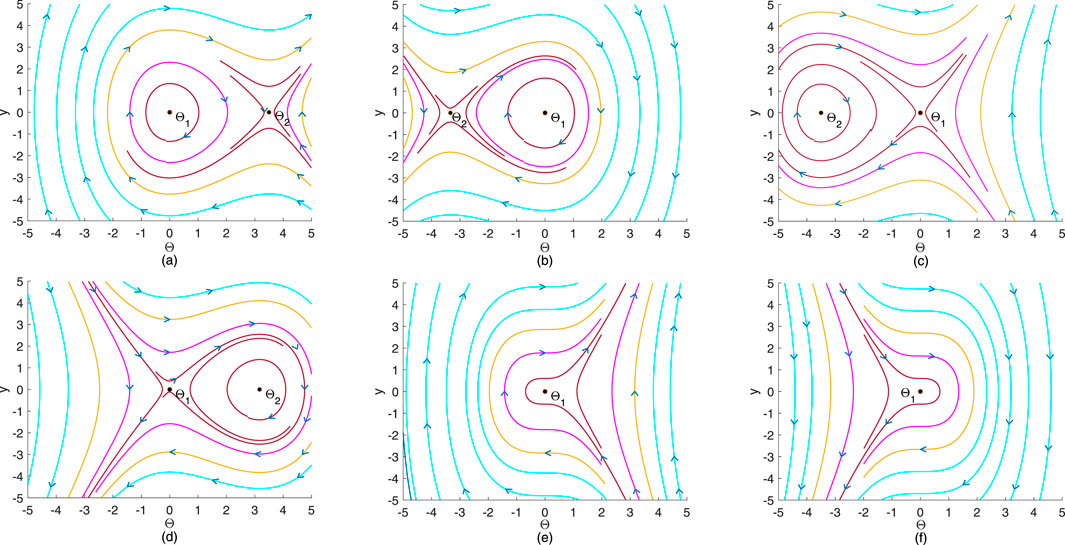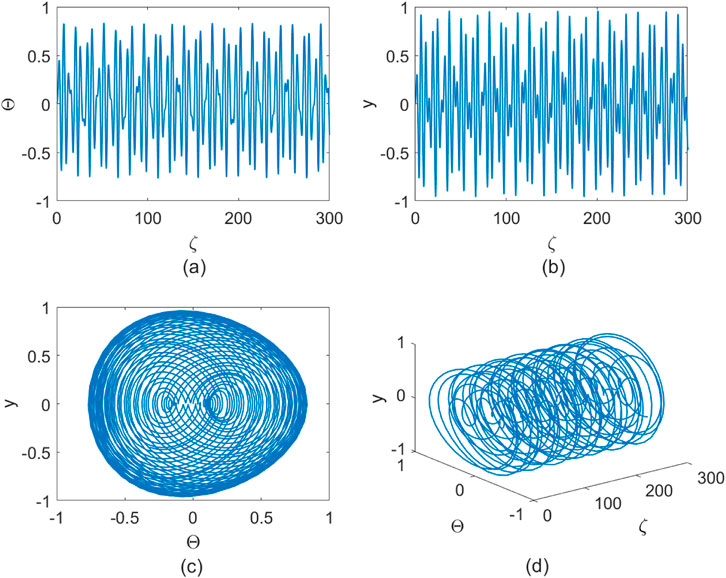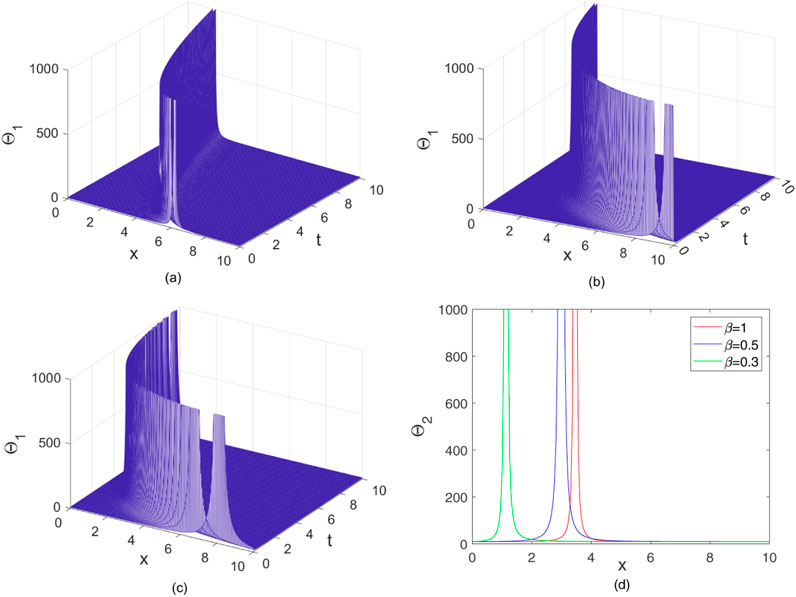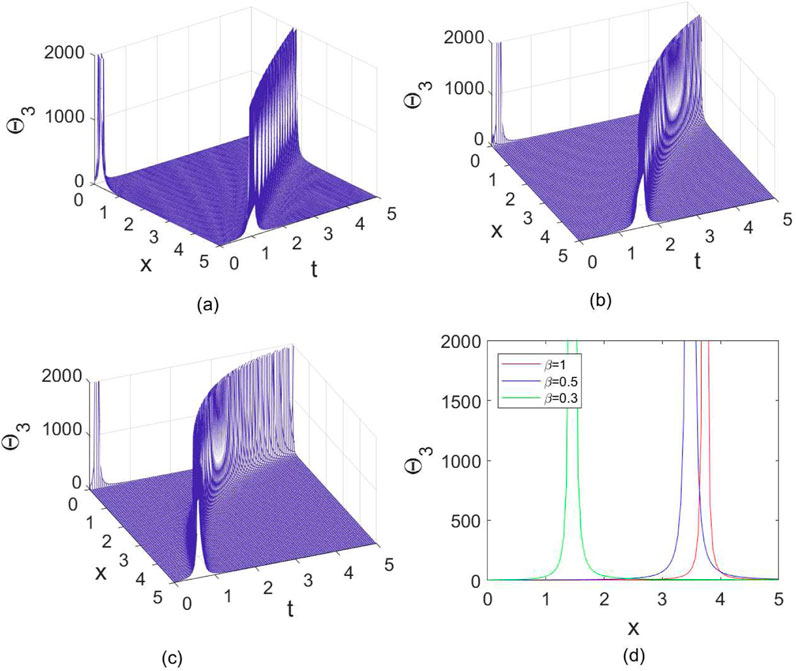- 1School of Electronic Information and Electrical Engineering, Chengdu University, Chengdu, China
- 2School of Computer Science, Chengdu University, Chengdu, China
The space–time fractional Zakharov–Kuznetsov–Benjamin–Bona–Mahony (ZKBBM) equation is a significant nonlinear model used to illustrate numerous physical phenomena, such as water wave mechanics, fluid flow, marine and coastal science, and control systems. In this article, the dynamical behavior of the space–time fractional ZKBBM equation is analyzed, and its traveling wave solutions are investigated based on the theory of the cubic polynomial complete discriminant system. First, the equation is transformed into a nonlinear ordinary differential equation through a complex wave transformation. Then, the dynamical behavior analysis of the equation is using the bifurcation theory from planar dynamical systems. Subsequently, by utilizing the polynomial complete discriminant system and root formulas, several new exact traveling wave solutions of the equation are obtained. Finally, the plots of some solutions are shown using MATLAB software in order to demonstrate their structure.
1 Introduction
A nonlinear fractional partial differential equation (NLFPDE) was first proposed by Zabusky and Kruskal in 1965 [1]. Fractional calculus is a natural extension of traditional integral calculus and plays a key role in describing some non-local and non-Markov processes. By studying and applying the solutions of NLFPDEs, we can better predict the behavior in complex systems [2] and provide more in-depth analysis and solutions for phenomena such as electromagnetic field propagation in nonlinear media [3], the growth and diffusion of biological tissues [4], seismic wave propagation [5], and groundwater flow [6]. Many literature studies have used various strategies to study the explicit solutions of nonlinear evolution equations, and an abundance of remarkable results has been obtained.
These approaches, like the Jacobi elliptic function [7, 8], the sine–cosine method [9, 10], the
Among the most well-known model equations, the ZKBBM equation is a vital type of NLFPDEs, which describes the phenomenon of gravitational water waves occurring when long waves propagate bidirectionally in a nonlinear dispersive system [28]. Many scholars studied the solution of this equation and its fractional form. To date, many types of traveling wave solutions of the ZKBBM evolution equation have been obtained utilizing the new
Stability is a critical factor in the design and control of a nonlinear system. By analyzing the equilibrium points and phase trajectories of the space–time fractional ZKBBM equation and observing its chaotic behavior, one can establish an important basis for the practical application of the system. Therefore, this paper investigates the dynamics of the space–time fractional ZKBBM equation according to the plane dynamics theory [37]. Furthermore, different forms of traveling wave solutions describe the same complex physical phenomenon in different ways and provide important initial and boundary conditions for numerical simulation. This allows for a more in-depth and comprehensive understanding of the properties of the equation and the structure of its solutions. In addition to the methods mentioned above, this paper uses the method of polynomial complete discriminant system proposed by Liu C [38] to derive a new traveling wave solution of the equation. This method has been widely used in solving a variety of NLFPDEs [39, 40], enabling the discovery of multiple types of solutions.
In this article, we adopt the following
For all
The space–time fractional ZKBBM equation ([28] and [35]) is given as follows:
where
The remainder of this work is structured as follows: Section 2 discusses the dynamical behavior and presents the wave equation of Equation 1.2. Section 3 provides several new traveling wave solutions of Equation 1.2 by utilizing the theory of cubic polynomial complete discriminant system and root formulas. In addition, some plots of the new solutions are showed using MATLAB software. Section 4 concludes the paper.
2 Dynamic analysis of Equation 1.2
In this section, we transform Equation 1.2 into a nonlinear ordinary differential equation using a complex traveling wave. Then, the dynamical behavior of Equation 1.2 is studied, which is exhibited through some phase portraits.
Implementing the following nonlinear complex wave transformation on Equation 1.2, we obtain
where
where
If
using the following Hamiltonian function
where
Let
The Jacobian determinant of Equation 2.4 is
Next, the two equilibrium points of Equation 2.4 are discussed based on the bifurcation theory of planar dynamical systems [37]. The correlative conclusions are provided as follows:
(I) If
(II) If
(III) If

Figure 1. Phase portraits of Equation 2.4. (a) λ1 = −2.1 and λ2 = 0.6. (b) λ1 = −2 and λ2=0.6. (c) λ1 = 2.1 and λ2 = 0.6. (d) Phase portrait with λ1 = 1.9 and λ2 = −0.6. (e) Phase portrait with λ1 = 0 and λ2 = 2.1. (f) Phase portrait with λ1 = 0 and λ2=−1.6.
Multiple attractors and bifurcation phenomena often occur in some nonlinear dynamical systems. Small perturbations can cause the system to shift from one attractor to another, causing the orbit of the system state to become irregular and chaotic. Therefore, we will explore whether Equation 2.4 has chaotic behavior in the case of small external perturbations. In order to simulate the chaotic phenomena in the system, a bounded periodic function can be added to Equation 2.4 as an uncertain perturbation factor. The new equations under the perturbation are described as
It can be found that when periodic perturbations are added, some systems become divergent, even though they were previously bounded, such as when

Figure 2. Chaotic behavior of Equation 2.8 at
3 Traveling wave solutions of Equation 1.2
In this section, some new exact traveling wave solutions of Equation 1.2 are studied based on the theory of the polynomial complete discriminant system [38] and root formula for a cubic polynomial equation. Finally, we demonstrate the solution structure using some two- or three-dimensional pictures.
3.1 Solving procedure
Equation 2.3 is integrated with regard to
where
We can obtain the integral form of Equation 3.2 as follows
where
According to the complete discrimination system (3.4), the solution of Equation 1.2 has the following four situations.
Case 1.
where
We substitute
where
Case 2.
We substitute
Case 3.
where
Furthermore,
If
where
If
where cn is the Jacobi elliptic cosine function. Substituting the specific expression of these variables
where
Case 4.
where
If
Substituting the specific expression of the following variables
where
3.2 Graphical description
To visualize the structure of these new solutions, the solutions

Figure 3. Figures of the solutions

Figure 4. Figures of the solutions

Figure 5. Figures of the solutions
4 Conclusion
This paper analyzes the dynamical behavior of the space–time fractional ZKBBM equation and presents seven types of new exact traveling wave solutions by utilizing the theory of the cubic polynomial complete discriminant system and root formulas. These new solutions, including rational, trigonometric, hyperbolic, and Jacobi elliptic function solutions, can be directly applied to simulation, prediction, and control in practical scenarios. Finally, the phase portraits and some of the solutions are plotted using MATLAB software. From these figures, we can clearly and intuitively understand the properties of the equation and the shapes of its solutions under different conditions.
Data availability statement
The original contributions presented in the study are included in the article/supplementary material; further inquiries can be directed to the corresponding author.
Author contributions
SZ: Writing – original draft. ZL: Writing – review and editing.
Funding
The author(s) declare that no financial support was received for the research and/or publication of this article.
Conflict of interest
The authors declare that the research was conducted in the absence of any commercial or financial relationships that could be construed as a potential conflict of interest.
Generative AI statement
The author(s) declare that no Generative AI was used in the creation of this manuscript.
Publisher’s note
All claims expressed in this article are solely those of the authors and do not necessarily represent those of their affiliated organizations, or those of the publisher, the editors and the reviewers. Any product that may be evaluated in this article, or claim that may be made by its manufacturer, is not guaranteed or endorsed by the publisher.
References
1. Zabusky NJ, Kruskal MD. Interaction of “solitons” in a collisionless plasma and the recurrence of initial states. Phys Rev Lett (1965) 15(6):240–3. doi:10.1103/physrevlett.15.240
2. Khan AM, Gaur S, Suthar DL. Predicting the solution of fractional order differential equations with Artificial Neural Network. Partial Differential Equations Appl Maths (2024) 10:100690. doi:10.1016/j.padiff.2024.100690
3. Deogan AS, Dilz R, Caratelli D. On the application of fractional derivative operator theory to the electromagnetic modeling of frequency dispersive media. Mathematics (2024) 12(7):932. doi:10.3390/math12070932
4. Megahid SF, Abouelregal AE, Sedighi HM. Modified Moore-Gibson-Thompson Pennes’ bioheat transfer model for a finite biological tissue subjected to harmonic thermal loading. Mech Time-depend Mater (2024) 28:1441–63. doi:10.1007/s11043-023-09647-3
5. Wang N, Xing G, Zhu T, Zhou H, Shi Y. Propagating seismic waves in VTI attenuating media using fractional viscoelastic wave equation. J Geophys Res Solid Earth (2022) 127:e2021JB023280. doi:10.1029/2021jb023280
6. Li Y, Zhou Z, Zhang N. Fractional derivative method for anomalous aquitard flow in a leaky aquifer system with depth-decaying aquitard hydraulic conductivity. Water Res (2024) 249:120957. doi:10.1016/j.watres.2023.120957
7. Fan E, Zhang J. Applications of the Jacobi elliptic function method to special-type nonlinear equations. Phys Lett A (2002) 305:383–92. doi:10.1016/s0375-9601(02)01516-5
8. Yan ZL. Abundant families of Jacobi elliptic function solutions of the (2+1)-dimensional integrable Davey–Stewartson-type equation via a new method. Chaos Solitons Fractals (2003) 18:299–309. doi:10.1016/s0960-0779(02)00653-7
9. Yan C. A simple transformation for nonlinear waves. Phys Lett A (1996) 224:77–84. doi:10.1016/s0375-9601(96)00770-0
10. Wazwaz AM. A sine-cosine method for handling nonlinear wave equations. Math Comput Model (2004) 40:499–508. doi:10.1016/j.mcm.2003.12.010
11. Wang M, Li X, Zhang J. The (G′, G)-expansion method and travelling wave solutions of nonlinear evolution equations in mathematical physics. Phys Lett A (2008) 372:417–23. doi:10.1016/j.physleta.2007.07.051
12. Zhang H. New application of the (G′, G)-expansion method. Commun Nonlinear Sci Numer Simulation (2009) 14:3220–5. doi:10.1016/j.cnsns.2009.01.006
13. Zaman UH, Arefin MA, Akbar MA, Uddin MH. Analyzing numerous travelling wave behavior to the fractional-order nonlinear Phi-4 and Allen-Cahn equations throughout a novel technique. Results Phys (2022) 37:105486. doi:10.1016/j.rinp.2022.105486
14. Uddin MH, Zaman UH, Arefin MA, Akbar MA. Nonlinear dispersive wave propagation pattern in optical fiber system. Chaos Solitons Fractals (2022) 164:112596. doi:10.1016/j.chaos.2022.112596
15. Harun-Or-Roshid MdAzizur Rahman. The e−ϕ(η)-expansion method with application in the (1+1)-dimensional classical Boussinesq equations. Results Phys (2014) 4:150–5. doi:10.1016/j.rinp.2014.07.006
16. Filiz A, Ekici M. Sonmezoglu A. F-expansion method and new exact solutions of the Schrödinger-KdV equation. Scientific World J (2014) 14.
17. Yang XF, Deng ZC, Wei Y. A Riccati-Bernoulli sub-ODE method for nonlinear partial differential equations and its application. Adv Difference equations (2015) 1:117–33. doi:10.1186/s13662-015-0452-4
18. Zafar A, Raheel M, Zafar MQ, Nisar KS, Osman MS, Mohamed RN, et al. Dynamics of different nonlinearities to the perturbed nonlinear schrödinger equation via solitary wave solutions with numerical simulation. Fractal and Fractional (2021) 5(4):213. doi:10.3390/fractalfract5040213
19. Islam MT, Aktar MA, Gómez-Aguilar JF, Torres-Jiménez J. Further innovative optical solitons of fractional nonlinear quadratic-cubic Schrödinger equation via two techniques. Opt Quan Electron (2021) 53:1–9. doi:10.1007/s11082-021-03223-0
20. Rani M, Ahmed N, Dragomir SS, Mohyud-Din ST, Khan I, Nisar KS. Some newly explored exact solitary wave solutions to nonlinear inhomogeneous Murnaghan’s rod equation of fractional order. J Taibah Univ Sci (2021) 15(1):97–110. doi:10.1080/16583655.2020.1841472
21. Islam MT, Akter MA, Gómez-Aguilar JF, Akbar MA. Novel and diverse soliton constructions for nonlinear space-time fractional modified Camassa-Holm equation and Schrodinger equation. Opt Quan Electron (2022) 54(4):227. doi:10.1007/s11082-022-03602-1
22. Li Z, Lyu J, Hussain E. Bifurcation, chaotic behaviors and solitary wave solutions for the fractional Twin-Core couplers with Kerr law non-linearity. Scientific Rep (2024) 14:22616. doi:10.1038/s41598-024-74044-w
23. Li Z, Zhao S. Bifurcation, chaotic behavior and solitary wave solutions for the Akbota equation. AIMS Maths (2024) 9:22590–601. doi:10.3934/math.20241100
24. Ma WX. Matrix integrable fourth-order nonlinear schrödinger equations and their exact soliton solutions. Chin Phys Lett (2022) 39(10):100201. doi:10.1088/0256-307x/39/10/100201
25. Ma WX. Matrix integrable fifth-order mKdV equations and their soliton solutions. Chin Phys B (2023) 32(2):020201. doi:10.1088/1674-1056/ac7dc1
26. Ma WX. Sasa-Satsuma type matrix integrable hierarchies and their Riemann-Hilbert problems and soliton solutions. Physica D (2023) 446:133672. doi:10.1016/j.physd.2023.133672
27. Li C, N’Gbo N’G, Su F. Finite difference methods for nonlinear fractional differential equation with ψ-Caputo derivative. Physica D (2024) 460:134103. doi:10.1016/j.physd.2024.134103
28. Hanif M, Habib MA. Exact solitary wave solutions for a system of some nonlinear space-time fractional differential equations. Pramana-j Phys (2020) 94(1):7. doi:10.1007/s12043-019-1864-6
29. Shakeel M, Tauseef Mohyud-Din S. New (G′/G)-expansion method and its application to the Zakharov-Kuznetsov CBenjamin-Bona-Mahony (ZKCBBM) equation. J Assoc Arab Universities Basic Appl Sci (2015) 18:66–81. doi:10.1016/j.jaubas.2014.02.007
30. Ali A, Iqbal MA, Mohyud-Din ST. Solitary wave solutions Zakharov-Kuznetsov-Benjamin-Bona-Mahony (ZK-BBM) equation. J Egypt Math Soc (2016) 24:44–8. doi:10.1016/j.joems.2014.10.008
31. Ali A, Iqbal MA, Tauseef Mohyud-Din S. Traveling wave solutions of generalized Zakharov-Kuznetsov-Benjamin-Bona-Mahony and simplified modified form of Camassa-Holm equation exp(−ϕ(η))-Expansion method. Egypt J Basic Appl Sci (2016) 3:134–40. doi:10.1016/j.ejbas.2016.01.001
32. Seadawy AR, Lu D, Khater MMA. Solitary wave solutions for the generalized Zakharov-Kuznetsov-Benjamin-Bona-Mahony nonlinear evolution. J Ocean Eng Sci (2017) 2:137–42. doi:10.1016/j.joes.2017.05.002
33. Salamat N, Arif AH, Mustahsan M, Missen MMS, Surya Prasath VB. On compacton traveling wave solutions of Zakharov-Kuznetsov-Benjamin-Bona-Mahony (ZK-BBM) equation. Comput Appl Maths (2022) 41:365. doi:10.1007/s40314-022-02082-z
34. Mehmet Baskonus H, Gao W. Investigation of optical solitons to the nonlinear complex Kundu-Eckhaus and Zakharov-Kuznetsov-Benjamin-Bona-Mahony equations in conformable. Opt Quan Electron (2022) 54:388. doi:10.1007/s11082-022-03774-w
35. Zaman UHM, Asif Arefin M, Ali Akbar M, Hafiz Uddin M. Stable and effective traveling wave solutions to the non-linear fractional Gardner and Zakharov-Kuznetsov-Benjamin-Bona-Mahony equations. Partial Differential Equations Appl Maths (2023) 7:100509. doi:10.1016/j.padiff.2023.100509
36. Alizadeh F, Hincal E, Hosseini K, Hashemi MS, Das A. The $$(2 + 1)$$-dimensional generalized time-fractional Zakharov Kuznetsov Benjamin Bona Mahony equation: its classical and nonclassical symmetries, exact solutions, and conservation laws. Opt Quan Electron (2023) 55:1061. doi:10.1007/s11082-023-05387-3
37. Jibin L, Huihui D. On the study of singular nonlinear traveling wave equations: dynamical system approach. Beijing: Science Press (2007).
38. Liu C. Applications of complete discrimination system for polynomial for classifications of traveling wave solutions to nonlinear differential equations. Comput Phys Commun (2010) 181:317–24. doi:10.1016/j.cpc.2009.10.006
39. Shan Z, Li Z. The analysis of traveling wave solutions and dynamical behavior for the stochastic coupled Maccari’s system via Brownian motion. Ain Shams Eng J (2024) 15:103037. doi:10.1016/j.asej.2024.103037
40. Shan Z. Chaos analysis and traveling wave solutions for fractional (3+1)-dimensional Wazwaz Kaur Boussinesq equation with beta derivative. Scientific Rep (2024) 14:23034. doi:10.1038/s41598-024-74606-y
Keywords: nonlinear fractional partial differential equation, bifurcation theory, dynamic analysis, planar dynamical system, polynomial complete discriminant system
Citation: Zhao S and Li Z (2025) Bifurcation, chaotic behavior, and traveling wave solutions of the space–time fractional Zakharov–Kuznetsov–Benjamin–Bona–Mahony equation. Front. Phys. 13:1502570. doi: 10.3389/fphy.2025.1502570
Received: 27 September 2024; Accepted: 31 March 2025;
Published: 29 April 2025.
Edited by:
Jevgenijs Kaupužs, Liepaja University, LatviaReviewed by:
André H. Erhardt, Weierstrass Institute for Applied Analysis and Stochastics (LG), GermanyYuanqing Wu, Dongguan University of Technology, China
Copyright © 2025 Zhao and Li. This is an open-access article distributed under the terms of the Creative Commons Attribution License (CC BY). The use, distribution or reproduction in other forums is permitted, provided the original author(s) and the copyright owner(s) are credited and that the original publication in this journal is cited, in accordance with accepted academic practice. No use, distribution or reproduction is permitted which does not comply with these terms.
*Correspondence: Shan Zhao, emhhb3NoYW5AY2R1LmVkdS5jbg==
 Shan Zhao
Shan Zhao Zhao Li
Zhao Li